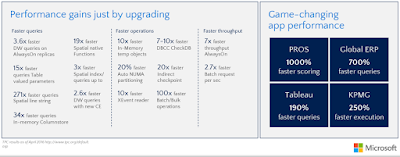The
following version of SQL Server, Microsoft’s flagship data source product, will
launch upon June 1, the organization announced today.
The
release follows Microsoft’s typical round of public previews and release
candidates because the company first announced this particular update in 2015.
Maybe the biggest distinction between this release cycle yet others is that the
company first tested most of the new features of SQL Server 2016 within its
Azure cloud.
Once
we reported earlier this 12 months, the focus of this particular update is on
pace and security (with a chance to perform some queries on encrypted data and
never have to decrypt it first), but with this particular new version,
Microsoft can also be positioning SQL Server like a solution for data
warehousing as well as big data analytics, because of both its built-in R
support and it is ability to store as well as query both structured as well as
unstructured data.
Clearly,
although, Microsoft is most looking forward to the speed-ups the revise
promises - even without having making any hardware modifications. The company
promises that many queries should now run typically 25 percent faster than
before (on exactly the same hardware). Microsoft also today announced a brand
new Lenovo benchmark that exhibits SQL Server 2016 operating on Windows Server
2016 (which continues to be in preview) handling a typical database test using
thirty terabyte of data faster than some of its competitors.
As
DocuSign VP associated with platform engineering Eric Fleischman explained, his
company currently utilizes SQL Server 2016 with regard to storing the metadata
of the hundreds and hundreds of transactions per second its users create about
the service, among other areas of its system. DocuSign has been screening SQL
Server 2016 as well as Fleischman called the performance gains it's been able
to achieve “off the actual charts. ” These overall performance gains, as well
since the addition of availability organizations, are what DocuSign is actually
most excited about in switching to the 2016 release.
Asked
why DocuSign didn’t opt for one of the numerous open-source competitor to SQL
Server, Fleischman explained that he looks from choosing SQL Server because
essentially a hiring choice. “When you pick SQL [Server] or other things, you
are making the hiring decision, ” he or she said. “Are they likely to help me?
We don’t wish to go write a data source. We want to make use of a team that
builds directories. That’s why we are staying about this train. The team is
actually receptive and helps all of us. ”
Along
with SQL Server 2016, Microsoft is also right now giving its customers in order
to stretch their database to Azure just in case they need a little more power
than their on-premise servers will offer.
As
Microsoft also these days announced, SQL Server 2016 will be four editions:
Enterprise, Regular, Express and Developer.
The
actual Developer edition, it’s really worth noting, will be readily available
for free and will offer all of the features of the complete enterprise edition
- although its license forbids utilizing it for production use instances. The
other free edition may be the Express edition, which may be used in production,
but it may only use up in order to 1GB of RAM and also the maximum database
size is actually 10 GB. It also doesn’t offer a few of the more high-end
features from the Standard and Enterprise models, including some of the actual
advanced high-availability, security, company intelligence and data warehousing
functions.
As
Microsoft senior overseer of Data Platform marketing Tiffany Wissner explained,
the pricing for the actual enterprise and standard editions won’t vary from
what Microsoft currently charges for that 2014 version (with the exception from
the developer version now being readily available for free). She also noted how
the team will likely continue exactly the same pattern of first liberating new
features on Azure after which bringing it to the actual boxed versions of SQL
Server following this release in July. Your woman did say, though, that the
team is actually looking at what all this means for the general release cadence
of SQL Server.
Techsourcenetwork


